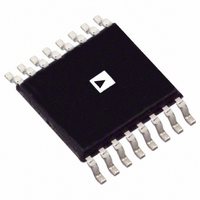AD8370AREZ Analog Devices Inc, AD8370AREZ Datasheet - Page 25

AD8370AREZ
Manufacturer Part Number
AD8370AREZ
Description
IC AMP VGA DIFF LN 16TSSOP
Manufacturer
Analog Devices Inc
Type
Var Gain Ampr
Datasheet
1.AD8370AREZ-RL7.pdf
(28 pages)
Specifications of AD8370AREZ
Amplifier Type
Variable Gain
Number Of Circuits
1
Output Type
Differential
Slew Rate
5750 V/ns
-3db Bandwidth
750MHz
Current - Input Bias
400pA
Current - Supply
79mA
Voltage - Supply, Single/dual (±)
3 V ~ 5.5 V
Operating Temperature
-40°C ~ 85°C
Mounting Type
Surface Mount
Package / Case
16-TSSOP Exposed Pad, 16-eTSSOP, 16-HTSSOP
No. Of Amplifiers
1
Bandwidth
750MHz
No. Of Channels
1
Supply Voltage Range
3V To 5.5V
Amplifier Case Style
TSSOP
No. Of Pins
16
Operating Temperature Range
-40°C To +85°C
Number Of Channels
1
Number Of Elements
2
Power Supply Requirement
Single
Common Mode Rejection Ratio
77dB
Voltage Gain Db
34dB
Input Resistance
0.0002@5VMohm
Input Bias Current
0.9@5VnA
Single Supply Voltage (typ)
5V
Dual Supply Voltage (typ)
Not RequiredV
Power Dissipation
575mW
Rail/rail I/o Type
No
Single Supply Voltage (min)
3V
Single Supply Voltage (max)
5.5V
Dual Supply Voltage (min)
Not RequiredV
Dual Supply Voltage (max)
Not RequiredV
Operating Temp Range
-40C to 85C
Operating Temperature Classification
Industrial
Mounting
Surface Mount
Pin Count
16
Package Type
TSSOP EP
Lead Free Status / RoHS Status
Lead free / RoHS Compliant
Current - Output / Channel
-
Gain Bandwidth Product
-
Voltage - Input Offset
-
Lead Free Status / Rohs Status
Compliant
Available stocks
Company
Part Number
Manufacturer
Quantity
Price
Company:
Part Number:
AD8370AREZ
Manufacturer:
ADI
Quantity:
1 636
Part Number:
AD8370AREZ
Manufacturer:
ADI/亚德诺
Quantity:
20 000
Part Number:
AD8370AREZ-REEL7
Manufacturer:
ADI/亚德诺
Quantity:
20 000
Company:
Part Number:
AD8370AREZ-RL7
Manufacturer:
AD
Quantity:
735
Part Number:
AD8370AREZ-RL7
Manufacturer:
ADI/亚德诺
Quantity:
20 000
APPENDIX
CHARACTERIZATION EQUIPMENT
An Agilent N4441A Balanced-Measurement System was used to
obtain the gain, phase, group delay, reverse isolation, CMRR,
and s-parameter information contained in this data sheet. With
the exception of the s-parameter information, T-attenuator pads
were used to match the 50 Ω impedance of this instrument’s ports
to the AD8370. An Agilent 4795A Spectrum Analyzer was used
to obtain nonlinear measurements IMD, IP3, and P1dB through
matching baluns and/or attenuator networks. Various other
measurements were taken with setups shown in this section.
COMPOSITE WAVEFORM ASSUMPTION
The nonlinear two-tone measurements made for this data sheet,
that is, IMD and IP3, are based on the assumption of a fixed
value composite waveform at the output, generally 1 V p-p. The
frequencies of interest dictate the use of RF test equipment, and
because this equipment is generally not designed to work in
units of volts, but rather watts and dBm, an assumption was
made to facilitate equipment setup and operation. Two sinusoidal
tones can be represented as
The RMS average voltage of one tone is
where T is the period of the waveform. The RMS average
voltage of the two-tone composite signal is
It can be shown that the average power of this composite
waveform is twice (3 dB) that of the single tone. This also
means that the composite peak-to-peak voltage is twice (6 dB)
that of a single tone. This principle can be used to set correct
input amplitudes from generators scaled in dBm and is correct
if the two tones are of equal amplitude and are reasonably close
in frequency.
V
V
1
2
T
T
1
1
= V sin (2∏f
= V sin (2∏f
T
T
∫
∫
0
0
( )
(
V
V
1
1
+
2
dt
V
2
=
)
2
dt
1
2
t)
t)
1
2
=
1
Rev. A | Page 25 of 28
DEFINITIONS OF SELECTED PARAMETERS
Common-mode rejection ratio (Figure 28) has been defined for
this characterization effort as
where the numerator is the gain into a differential load at the
output due to a differential source at the input, and the
denominator is the gain into a differential-mode load at the
output due to a common-mode source at the input. In terms of
mixed-mode s-parameters, this equates to
More information on mixed-mode s-parameters can be
obtained in a reference by Bockelman, D.E. and Eisenstadt,
W.R., Combined Differential and Common-Mode Scattering
Parameters: Theory and Simulation. IEEE Transactions on
Microwave Theory and Techniques, v 43, n 7, 1530 (July 1995).
Reverse isolation (Figure 26) is defined as SDD12.
Power supply rejection ratio (PSRR) is defined as
where A
A
taken together) to the output (OPLO and OPHI, taken
differentially), corrected for impedance mismatch. The
following reference provides more information: Gray, P.R.,
Hurst, P.J., Lewis, S.H. and Meyer, R.G., Analysis and Design of
Analog Integrated Circuits, 4
page 422.
s
is the gain from the power supply pins (VCCI and VCCO,
SDD
SDC
A
Differenti
A
Common
dm
s
dm
21
21
is the differential mode forward gain (SDD21), and
al
Mode
Mode
Gain
Gain
th
Edition, John Wiley & Sons, Inc.,
AD8370











